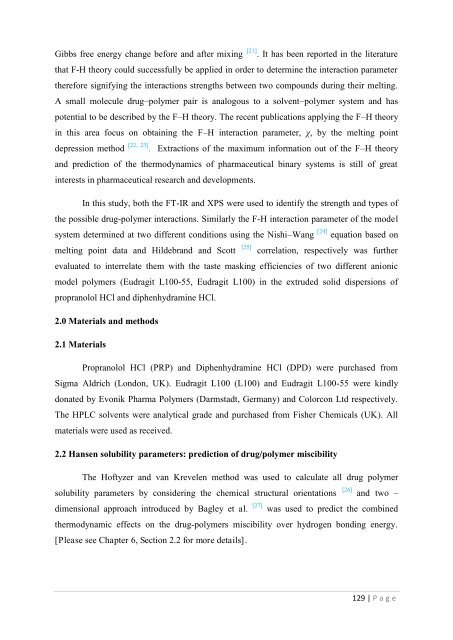Development of hot-melt extrusion as a novel technique for the ...
Development of hot-melt extrusion as a novel technique for the ...
Development of hot-melt extrusion as a novel technique for the ...
Create successful ePaper yourself
Turn your PDF publications into a flip-book with our unique Google optimized e-Paper software.
Gibbs free energy change be<strong>for</strong>e and after mixing [21] . It h<strong>as</strong> been reported in <strong>the</strong> literaturethat F-H <strong>the</strong>ory could successfully be applied in order to determine <strong>the</strong> interaction parameter<strong>the</strong>re<strong>for</strong>e signifying <strong>the</strong> interactions strengths between two compounds during <strong>the</strong>ir <strong>melt</strong>ing.A small molecule drug–polymer pair is analogous to a solvent–polymer system and h<strong>as</strong>potential to be described by <strong>the</strong> F–H <strong>the</strong>ory. The recent publications applying <strong>the</strong> F–H <strong>the</strong>oryin this area focus on obtaining <strong>the</strong> F–H interaction parameter, , by <strong>the</strong> <strong>melt</strong>ing pointdepression method [22, 23] . Extractions <strong>of</strong> <strong>the</strong> maximum in<strong>for</strong>mation out <strong>of</strong> <strong>the</strong> F–H <strong>the</strong>oryand prediction <strong>of</strong> <strong>the</strong> <strong>the</strong>rmodynamics <strong>of</strong> pharmaceutical binary systems is still <strong>of</strong> greatinterests in pharmaceutical research and developments.In this study, both <strong>the</strong> FT-IR and XPS were used to identify <strong>the</strong> strength and types <strong>of</strong><strong>the</strong> possible drug-polymer interactions. Similarly <strong>the</strong> F-H interaction parameter <strong>of</strong> <strong>the</strong> modelsystem determined at two different conditions using <strong>the</strong> Nishi–Wang [24] equation b<strong>as</strong>ed on<strong>melt</strong>ing point data and Hildebrand and Scott [25] correlation, respectively w<strong>as</strong> fur<strong>the</strong>revaluated to interrelate <strong>the</strong>m with <strong>the</strong> t<strong>as</strong>te m<strong>as</strong>king efficiencies <strong>of</strong> two different anionicmodel polymers (Eudragit L100-55, Eudragit L100) in <strong>the</strong> extruded solid dispersions <strong>of</strong>propranolol HCl and diphenhydramine HCl.2.0 Materials and methods2.1 MaterialsPropranolol HCl (PRP) and Diphenhydramine HCl (DPD) were purch<strong>as</strong>ed fromSigma Aldrich (London, UK). Eudragit L100 (L100) and Eudragit L100-55 were kindlydonated by Evonik Pharma Polymers (Darmstadt, Germany) and Colorcon Ltd respectively.The HPLC solvents were analytical grade and purch<strong>as</strong>ed from Fisher Chemicals (UK). Allmaterials were used <strong>as</strong> received.2.2 Hansen solubility parameters: prediction <strong>of</strong> drug/polymer miscibilityThe H<strong>of</strong>tyzer and van Krevelen method w<strong>as</strong> used to calculate all drug polymersolubility parameters by considering <strong>the</strong> chemical structural orientations [26] and two –dimensional approach introduced by Bagley et al. [27] w<strong>as</strong> used to predict <strong>the</strong> combined<strong>the</strong>rmodynamic effects on <strong>the</strong> drug-polymers miscibility over hydrogen bonding energy.[Ple<strong>as</strong>e see Chapter 6, Section 2.2 <strong>for</strong> more details].129 | P a g e
















